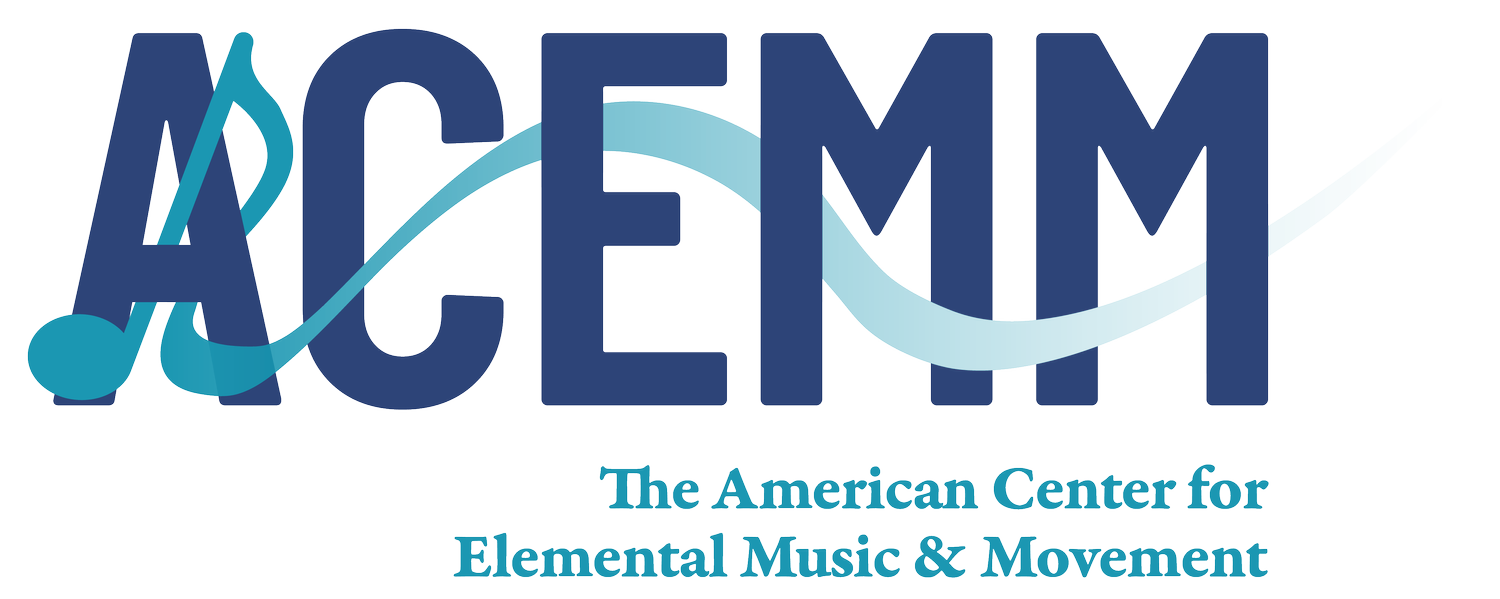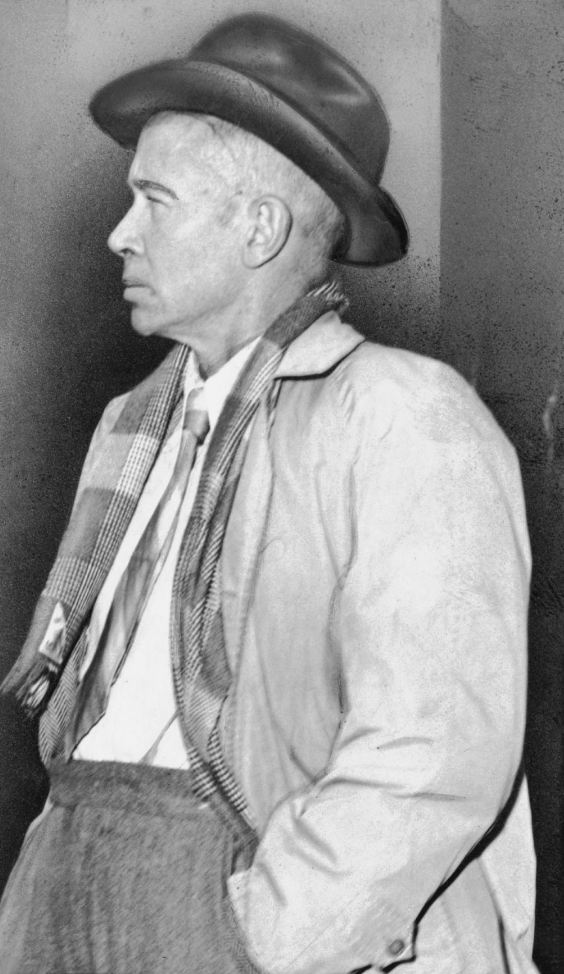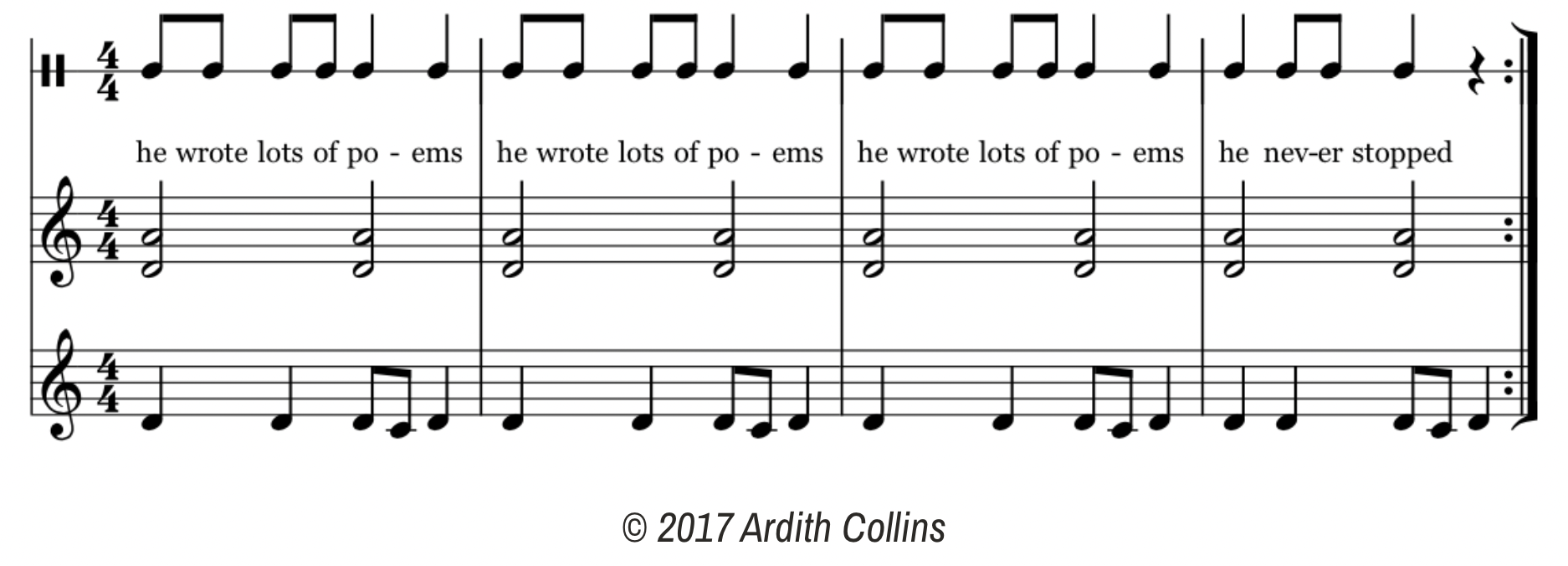E. E. Cummings through the lens of Elemental Music and Movement
by Ardith Collins
2014 ACEMM Beacon Scholarship recipient
E. E. Cummings’ profound simplicity speaks to the heart of elemental music, and his expressive typography is a joy to share with upper elementary and middle school students who may connect with Cummings’ creative uses of punctuation, grammar and syntax.
This activity offers and entry point with a piece inspired by Carl Orff and Gunild Keetman’s Music for Children, poetry by E. E. Cummings, and the nonfiction text enormous SMALLNESS ~ A Story of E. E. Cummings. Teachers are encouraged to use these ideas as an entry point to sing, say, dance, and play, as well as a springboard for movement, improvisation, composition, research and interdisciplinary connections with upper elementary and/or middle school students.
E. E. Cummings
In Ardith’s words:
E. E. Cummings has long been a favorite poet of mine. When I noticed the book enormous SMALLNESS ~ A Story of E. E. Cummings by Matthew Burgess, illustrations by Kris Di Giacomo on display in my school library, I was immediately compelled to share it with my students.
Biography and poetry of E.E. Cummings
Beginning with a short melody and ostinato idea played on xylophone, this foray into E. E. Cummings life and works germinated into a multi-dimensional experience for upper elementary/middle school students.
i: a 4/4 starting point for learning about E. E. Cummings, paired with an inspiring quote of E.E.’s and one of his favorite words – yes!
After reading about E.E.’s early life in enormous SMALLNESS, I began with a foundation of a simple ostinato and half note drone:
Reflecting on Cummings’daily habit of writing a poem every day from the age of 8 to 22, my students added the part for hand drum, kept a steady beat on a cowbell, and played finger cymbals on the rest after stopped.
Children enter our classrooms with a natural curiosity, and as elemental-inspired educators, we should seek every opportunity to build upon the inquisitive nature of students.
Facilitating elemental exploration
Try asking questions that prompt the exploration of musical possibilities and cultivate artistry, such as:
*What could the form be?
Should we have an introduction?
Could we add a B Section?
How shall it end? (inevitably, my students love ending with Gong!)
Could we incorporate body percussion? More instruments? Movement?
Working in an elemental way, teachers can guide students from one simple idea to an increasingly complex network of ideas. Making choices about these ideas usually results in a musically satisfying arrangement, accessible to students of varying skill levels with truly limitless possibilities.
Model as Inspiration
Children enter our classrooms with a natural curiosity, and as elemental-inspired educators, we should seek every opportunity to build upon the inquisitive nature of students, to guide them to learn about the world in playful and joyful ways, make connections that last beyond the constructs of the class period, and facilitate learning across all content areas.
In this lesson, E. E. Cummings is the model, and the initiating elements were a simple melody and ostinato with text inspired by his life and words. An exploration of E. E. Cummings’ poetry provided a content-rich environment where students are encouraged to mine for ideas (elements) that provide meaning for them. E. E. Cummings provides both model and inspiration with simple structures through an artistically crafted approach.
Edward Estlin Cummings broke established rules of space, order, and punctuation. He turned words on their side, creating “eye music;” an interplay of art and text. As an artist of multiple disciplines, E.E. recognized similarities of phrase, timbre, and pitch in speech and music, observing how melodies go “up and down, jump and glide…along the surface of harmonies” Cummings approached sound patterns on a level that precedes the signified, dividing words and using syllables as a composer uses melodic and rhythmic sounds; more can be read about that in this piece by Martina Anteater. Cummings’ biographer Christopher Sawyer-Lauçanno noted E. E. was “attempting to create poetry that could appeal equally to the eye, ear, and mind,” as well as invoking “sound into shape” (p 95).
Demystifying E. E. Cummings
Students may initially struggle interpreting the simple complexity of E.E. Cummings; an excellent resource for teachers on interpreting Cummings’ work is: How E.E. Cummings writes a poem
It may help to show your students a glimpse of his home at 4 Patchin Place in lower Manhattan. This was E. E. Cummings home for over 40 years.
While E. E. Cummings utilized lower case letters in his works, he never intended for his own name to forego capitalization; you can read more about that here.
4 Patchin Place. E. E. Cummings’ home for 40 years.
Pathways to inspire student creativity:
After drawing back the veil of mystery around E. E. Cummings, helping students to think a bit like the poet can be an invitation to create in a similar vein. Facilitating a consideration of these questions and more importantly the students responses will bring clarity to how learners are engaging with E. E.’s work. Articulating Who, What, When Where, Why and How? answers will become the inspiration for students to move forward with their own creativity. Simply replace E. E. Cummings’ name with “we.”
“What was E.E. Cummings able to convey deconstructing sentences into letters and symbols?” becomes “What are we able to convey by deconstructing sentences into letters and symbols. Could we do this with music, movement, instruments, props?”
“How did E. E. use repetition in his work?” becomes “How could we use repetition in a musical context?
“Where does E.E. Cummings show movement in poetry?” becomes “How could we show movement in our body that reflects the movement E.E. shows in his poetry?”
“How does E.E. Cummings convey his ideas to an audience?” becomes “How could we convey our ideas about E.E. Cummings in a musical way with an audience?”
Adaptability and Resonance
There is a freedom in facilitating learning for students using an elemental approach. It provides a direct route to the hearts and minds of students, affirms their values, and serves as the media for creation within a context. The challenge can be to structure this in a manageable way to preserve standards of classroom behavior. Building a community of learners who respect this process takes time and yet might actually be the fastest way to facilitate high standards of respect in general. In striving to share peaceful, fruitful collaborations that promote classroom cohesion, we fulfill goals far beyond music and movement objectives.
There is a freedom in facilitating learning for students using an elemental approach.
Aside from, and more pronounced than the benefits of such an approach regarding classroom behavior expectations is the way that work like this resonates over time with students. Vividly remembering what they are creating, being able to carry it with them and recall with no “review” is a regular occurrence. When music and movement ideas are awakened in learners through the elemental approach, the resonance within them is almost everlasting! The power of experiences like these can be life-changing, and eternal!
Poetryfoundation.org is an excellent resource to find poems to share with your students, and May is Get Caught Reading Month, but any time is a perfect time to share literacy connections with our students.
I hope this lesson idea provides inspiration for your own teaching, and an opportunity to open the eyes and ears of all who pass through your classroom to the vast, joyful, connected world that surrounds us, allowing your students to connect to the world, to themselves, and to the future, in a way that is true to the creative spirit of both E. E. Cummings and elemental music and movement. I would love to hear the ways your students rearrange the ideas, ad libitum, to blossom into a creation of their own. Have fun exploring the possibilities, and please share!
Ardith Collins teaches string ensemble, general music, and after school mallet percussion at Copeland Middle School. She is the District Articulator of Fine & Performing Arts for grades preK – 8 in Rockaway Township, New Jersey, and is Adjunct Professor of Strings Techniques at Montclair State University John J. Cali School of Music. Ardith received her bachelor’s and master’s degrees from The College of New Jersey. Her summative masters research was on movement and music, which inspired her to pursue Orff Schulwerk Levels and Kodály training. Ardith completed Orff Certification through Villanova/University of the Arts and Kodály Levels I & II at Westminster Choir College. Ardith was the 2014 American Center for Elemental Music and Movement (ACEMM) Beacon Scholarship recipient, which she utilized to attend JaSeSoi ry ~ Orff World Village in Valkeala, Finland. Ardith is Vice-President of the Northern New Jersey Orff Schulwerk Association, is an active member in the Elementary Division of the North Jersey School Music Association (NJSMA/NJMEA), an avid folk dancer, rounds enthusiast, and performs with the Montclair State University Balkan Ensemble.






